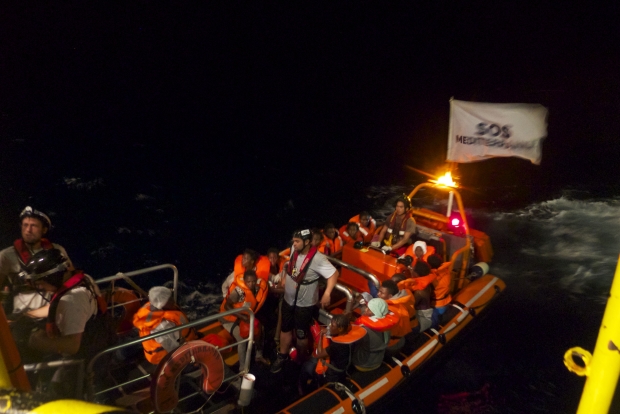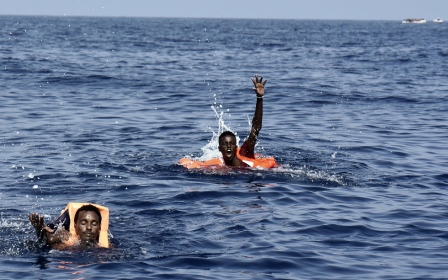Night rescue: Saving lives in the Mediterranean

A thin beam of light from the spotlight on board the Search and Rescue (SAR) ship MV Aquarius pierced the darkness, scanning the choppy black waves until it caught the fluorescent glare of a row of orange lifejackets crowded tightly into a 15-metre inflatable dinghy.
One of the vessel's small rescue boats was craned down from the ship’s deck and sped out into the darkness towards the illuminated dinghy, carrying a Medicins Sans Frontiéres (MSF) medic and multilingual cultural mediator Amani Teklehaimanot.
“Doing night rescues is very risky, and it's very scary for these people and for us, especially now when the weather is getting rougher,” he told MEE. “People have spent long hours at sea by the time [we reach them] so they are frightened, which makes it more dangerous.”
As the first person to approach a migrant dinghy and one who stays alongside throughout the entire rescue operation, his job is to keep everyone in the dinghy calm, restricting movements which could destabilise the boat, and identifying whether there are any women, children or injured people aboard - priorities during the first stage of the operation.
“I feel very emotional inside: seeing people barefoot, their clothes soaked with sea water and fuel. You see such a lot of facial expressions on the approach,” Teklehaimanot said.
Faces full of terror, desperation and hope stare out at him, with many crying or praising God that they have been found. Himself an Eritrean refugee who made that same dangerous Mediterranean boat journey 15 years ago, Teklehaimanot truly understands the suffering of those on board - but, he said, he only focuses on reassuring them, instilling a crucial sense of calm that can be the difference between life and death. He explains in multiple languages that the Aquarius is an NGO search and rescue vessel with enough space for everyone, but that the rescue will take time.
Denied permission to enter Libyan waters
This dinghy had been drifting all day in the hot sun with a broken engine, its exact location unknown since that morning, when a military helicopter had dropped lifejackets down to it. It took hours for the Aquarius - operated by new NGO SOS Mediterranee in partnership with MSF - to find the tiny boat. From its last known coordinates, volunteers scanned the horizon with binoculars until, almost imperceptible, the dinghy bobbed softly up onto the distant horizon for a few seconds.
Adrift in Libyan territorial waters, which European rescue vessels cannot enter without permission, the frustrated crew of the Aquarius could only wait, keeping binoculars fixed on the boat. The Libyan coastguard denied the SAR vessel permission to enter their waters, insisting they would deal with the dinghy. But four hours later there had still been no sign of any Libyan rescue vessel. As dusk fell, the wind changed, gently nudging the dinghy out into international waters and finally enabling the Aquarius to start rescue operations.
While Teklehaimanot’s boat bobbed alongside the dinghy, with the medic and extra lifejackets, monitoring the condition of those on board, a second rescue boat set out into the darkness to begin the long, slow and challenging process of transferring passengers to safety in groups of 20.
'Either they can see us or we can see them'
“Night rescues are more intense because people are generally more nervous and unpredictable at night,” said deputy SAR coordinator and rescue boat leader Max Orlando Avis, running through the different factors that can affect the operation. “With the searchlights, either they can see us or we can see them and, because people are generally more scared at night, it’s better if they can see us. But the problem then is that we can’t always see what they are doing - there is a chance they might try to jump into the rescue boat but slip into the water, and finding people in the water at night is much harder.”
Reaching into the dinghy to haul one person out at a time, Avis led the rescue, with colleagues helping drag each passenger aboard, seating them along the edges of the rescue boat.
“There is humanity still, even in these desperate circumstances, and sometimes others in the boat will try to help. People do what they can but are sometimes so weakened by malnutrition that they are in no position to help,” he explained. “Often, several people will try to grab your arm at the same time but then you have to pause the rescue and explain that we can only take people one by one.”
Although the rescuers play down the risks, transferring people between small boats on a rolling night sea is dangerous, and success depends as much on the cooperation of the migrants and suitable sea conditions as the professionalism of those undertaking the rescues.
Night rescues - and risks - on the rise
“Every rescue is different - different conditions, different boats, different situations, and you can never predict what will happen,” said Aquarius bosun and captain of the main rescue boat Ralph Montehermoso. “You have to be aware of the waves as much as the people you are rescuing because both can change very quickly.”
Although usually able to respond to the challenges created by sea conditions, he said the reactions of people he tries to save are often more challenging. “We explain again and again that everyone will be saved but they are tired and they sometimes fight each other for lifejackets or because they want to be first into the rescue boat,” he said.
“Especially at night with big waves or if their boat is already sinking, they are in a state of panic and everyone wants to go first.”
As the seasons change, bringing rougher seas, people smugglers in Libya are grabbing any days of good weather to set as many migrant boats as possible to sea. The consequences of this predominantly fall on the shoulders of the 12 NGO rescue vessels currently operating in the central Mediterranean Sea.
“Night rescues are becoming more frequent - it's a change we have seen in the last month,” explained MSF project coordinator Ferry Schippers. “During the summer, the boats usually left between 12am and 2am so we would find them in the morning but there is a new tendency for them to leave during the day, possibly because the weather windows are smaller now winter is approaching. Now we are seeing many night rescues.”
The men hauled up to the safety of the Aquarius’ deck were in a desperate state - barefoot and shaking, their ragged clothes glued to their bodies with seawater - and most were unable to speak except to utter their names and country of origin through chattering teeth. Severely dehydrated, some had been forced to drink sea water during the journey. Others were painfully thin, suffering from malnutrition after spending months in Libyan detention centres, their skin peppered with infected scabies rashes.
Some had severe burns covering their legs, from sitting in a noxious mix of diesel and seawater that swirled around inside the boat. A few men reeled and collapsed on the deck, even before they could wrap themselves in the blankets provided in the boat’s little rescue bags, and were attended to by MSF medics.
While the migrants, now uniformly dressed in white T-shirts and navy blue tracksuits, curled up under their blankets to sleep on the deck of the Aquarius, the rescue crew prepared for a second night-time operation.
Another MSF SAR vessel - MV Dignity - was struggling to manage the hundreds of people it had rescued that day, and for whom it had no space left on deck. More than one hundred people, including women and children, needed to be transferred to the larger vessel Aquarius, in a series of small journeys that can be even more dangerous than rescuing the boats. A long night lay ahead before the SAR vessel could turn around and head towards Italy, with 521 rescued migrants aboard.
Middle East Eye propose une couverture et une analyse indépendantes et incomparables du Moyen-Orient, de l’Afrique du Nord et d’autres régions du monde. Pour en savoir plus sur la reprise de ce contenu et les frais qui s’appliquent, veuillez remplir ce formulaire [en anglais]. Pour en savoir plus sur MEE, cliquez ici [en anglais].






